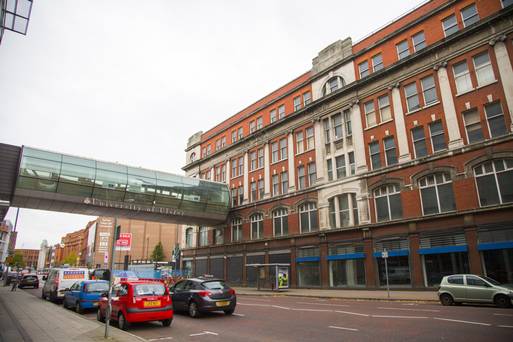It was once one of Belfast’s most popular department stores, fondly remembered down the generations for its spectacular Christmas window displays.
Now the beautiful Orpheus building on York Street is about to be razed to the ground, taking with it years of history.
The demolition of the neighbouring Metropole building over the weekend sparked fury on social media, and heritage campaigners are appealing to the public to make their concerns known directly to Belfast City Council.
Condemning the demolition, the Ulster Architectural Heritage Society says it has been calling for an alternative plan for the nearby Ulster University development since 2011, one that would integrate irreplaceable historic buildings into its plans.
“It appears that the university is going ahead with the complete demolition of this group of buildings, signalling further erosion to Belfast’s already compromised historic environment,” a spokesman said. “Both the Orpheus and Metropole buildings are among the limited and increasingly diminishing stock of Belfast buildings in the art deco style.
“Belfast’s historic environment has already been compromised by the loss of built heritage to the Blitz and the Troubles.
“This has been compounded by a limited appreciation on the part of main government and corporate bodies of the advantages of heritage led regeneration.
“It is regrettable to see the Orpheus and Metropole join the old Great Victoria Street Station, the Grand Central Hotel and Great Victoria Street Baptist Church, incorporating ‘Belfast’s smallest house’ in a long list of buildings which we now mourn.”
Neither building was listed.
“In an attempt to protect the buildings, UAHS twice put the Orpheus forward to the Department of the Environment (DoE) for listing.
“Unfortunately, these considerations were not successful in changing the progression of the plans, and demolition was approved by the DoE in 2013 – a decision made prior to local government reform and transfer of planning to Belfast City Council.”
Ulster University said: “The demolition of these buildings is a necessary step in the development of the new Belfast campus – a development which will maximise opportunities for our students as part of a new era for the University and this part of Belfast city.”
A DoE spokesperson said: “In deciding to approve the new campus proposal, and therefore accepting the demolition of the Orpheus and Metropole buildings, the department fully assessed the development proposals, having particular regard to relevant architectural and built heritage issues. This included an assessment against the policies contained in Planning Policy Statement 6 – Planning, Archaeology and the Built Heritage.
“In advance of this application, the department responded to requests to consider the Orpheus Building for listing. After a detailed assessment it concluded that this building did not meet the legislative requirement for such protection.”
The Orpheus, built in 1932, currently serves as a home for Ulster University’s Art College.
A key example of art deco style, the building has a fantastic original core – a fine staircase, timber panelling and stained glass windows. The rare survival of Belfast city centre’s last ‘Ballroom of Romance’ on the top floor, with its curved plasterwork ceiling, underscores its social as well as architectural importance.
Read this article and more at the Belfast Telegraph.




